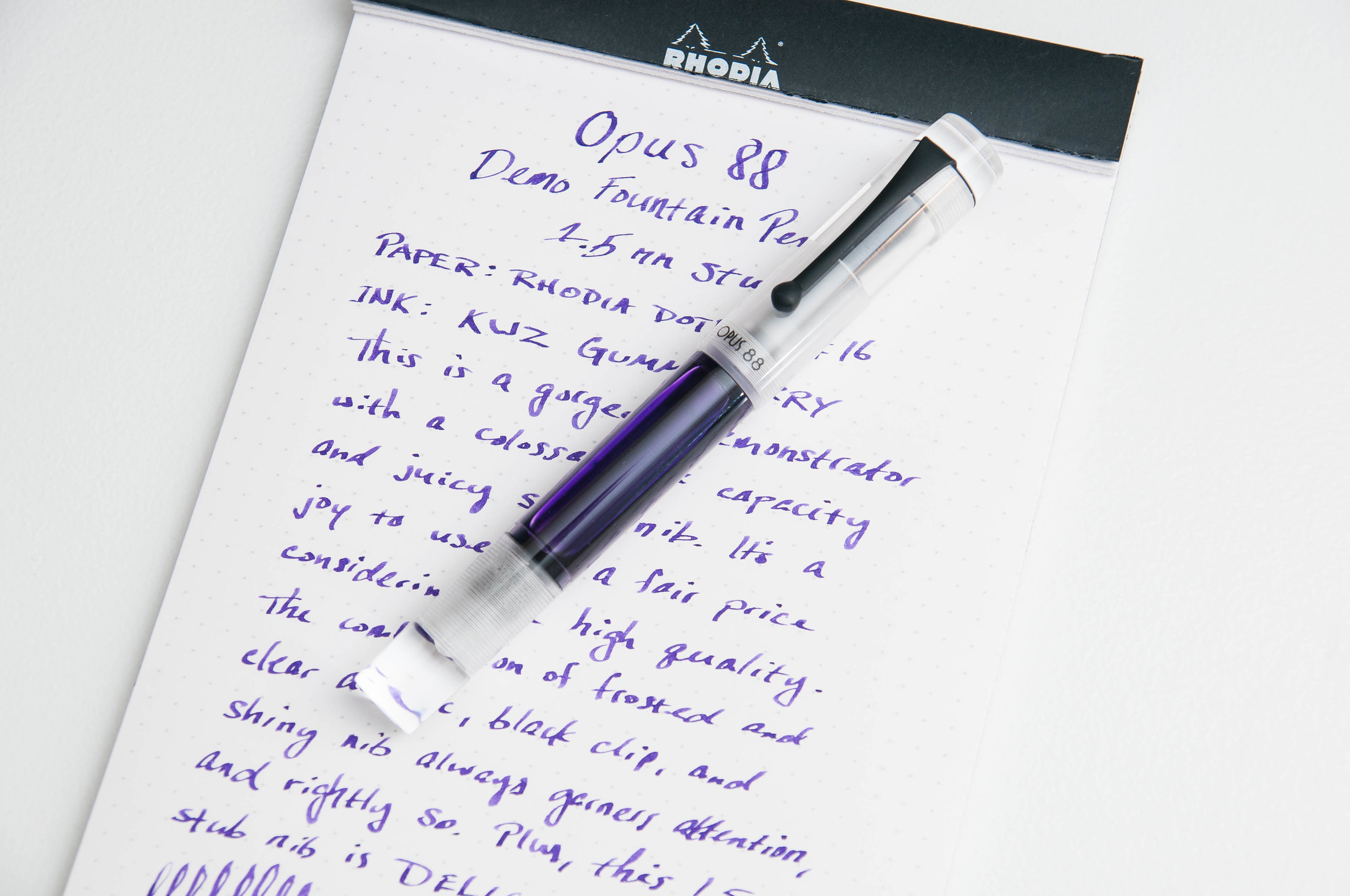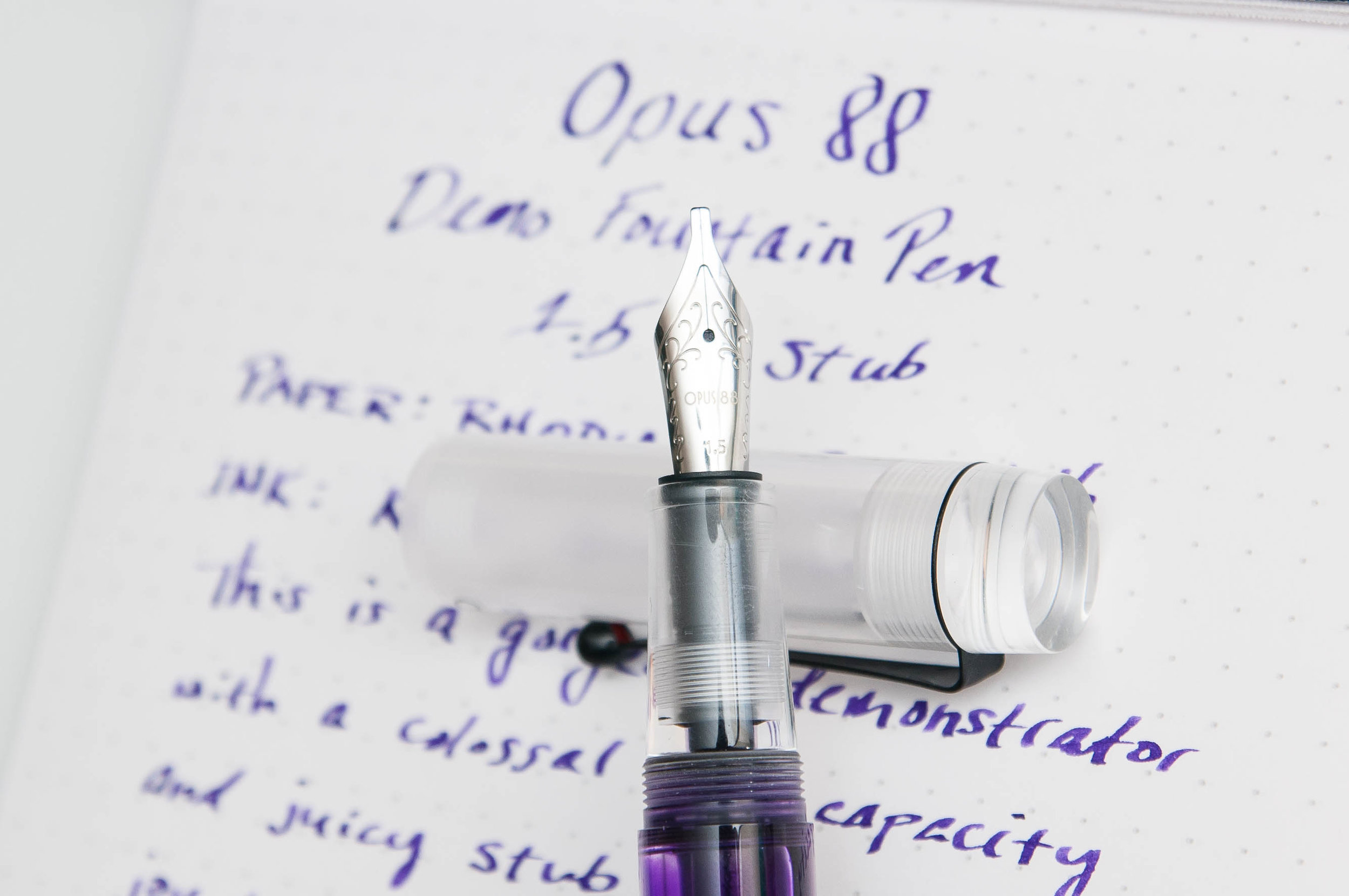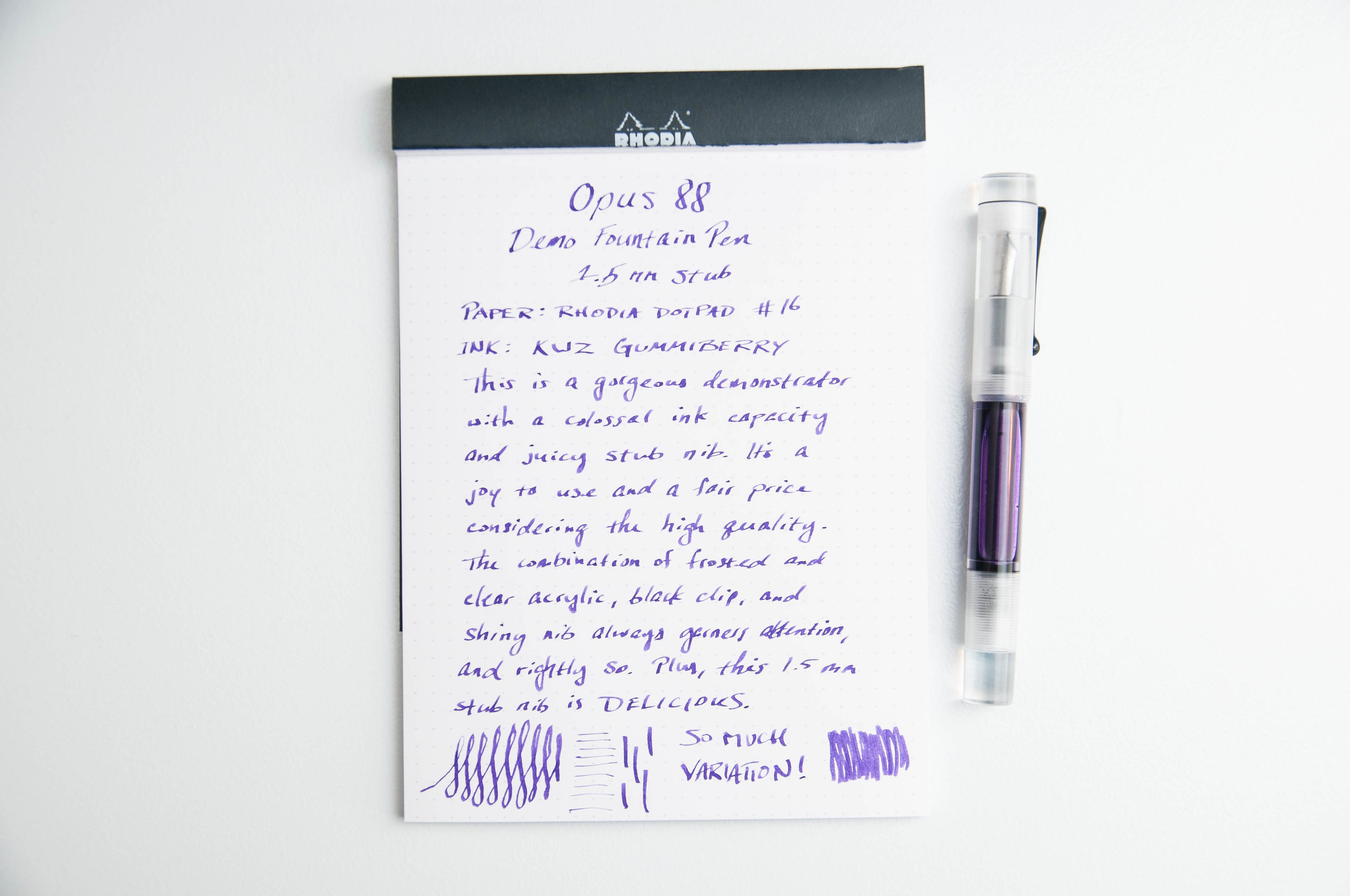(Jeff Abbott is a regular contributor at The Pen Addict. You can find more from Jeff online at Draft Evolution and Twitter.)
The Opus 88 Demonstrator is a relative newcomer on the fountain pen stage, but it's also made quite a splash. I'm sure you've seen or heard of the Opus 88 line, and chances are you've seen the Demonstrator, as it's one of the most common models. It's well-known for good reason, and packs quite a punch into the acrylic package.
I got my hands on the 1.5mm stub version of the clear demonstrator, and I couldn't be happier with it. First off, I have to say that I had an incredibly difficult time picking a color. Between the gray, red, orange, and clear demonstrators, it's a nearly impossible choice for some. They all look so great. But, in the end, I went with the classic clear demonstrator since it felt like the most representative of the pen's style and aesthetic.
For this review, I chose KWZ Gummiberry to show off the wonderful 1.5mm stub nib as well as the clear acrylic ink reservoir. The yummy purple ink does a great job of showcasing both the nib and reservoir that I've struggled to put anything else in it so far.
Starting at the first impressions of this pen, it's quite large. At 5.75 inches or 14.6 cm, it's definitely a full-size fountain pen that even makes the Pilot Custom 823 look average. It's no Sailor King of Pen, but it's also a fraction of the price. Aside from the size, one of my favorite features of this pen — especially the demonstrator model — is the mixture of frosted and polished acrylic. This mixture of textures creates such a unique and beautiful aesthetic. The top and bottom finials are incredibly polished and manipulate light as it passes through to the other side. The inside of the cap is frosted, allowing a blurry peek at the nib that rests inside, while the ink reservoir is also polished to show off the color of the ink inside. These subtle touches really add a lot to this pen that I enjoy.
The clip is also a nice bit of contrast to the frosty and bright acrylic features. It's a black-ish matte color that really stands out from the rest of the pen. It's also quite strong and well made. For a pen of this size, that's a must. Just below the bottom of the clip is the only branding you'll find on this pen. An elegant "Opus 88" is stamped on the cap band, and it can be easy to miss if you aren't looking for it.
Moving on to the body, the exterior is completely polished, allowing you to see all the innards clearly. The only parts that appear frosted are the threaded parts, but that's more texture that adds to the overall aesthetic. The grip section is nice and smooth with a clear view of the feed mechanism, and then you get to the nib. This glorious JoWo #6 is the perfect size for this pen. It's a shiny material with a tiny Opus 88 etching above the nib size stamp. The 1.5mm stub is hard to miss on this pen.
Moving down the body to the end of the pen, you encounter the blind. There's plenty of polished material here to grip while untwisting the blind to allow the ink to flow freely into the feed section. There's a bit of squeaking as you tighten and loosen the material, but it starts to dissipate after several dozen iterations. Again, the highly polished material is fun to look at and watch how the light interacts with it. In some light, it just looks like a vial of ink sitting on your desk. Which leads us to...
The filling system and ink reservoir. Oh my. This pen holds so much ink. I haven't measured, but I'm sure I can easily fit 5ml of ink in this pen. The Demonstrator comes with a glass eyedropper for filling, but I used a syringe I had lying around. To fill the pen, simply unscrew the section from the body to expose the reservoir, inject the ink (either by eyedropper or another method), replace the section, unscrew the blind a few turns, and wait for the ink to soak through the feed. It's such a simple system, and it works so well. I love piston fillers, but they require extra attention and focus when filling all the way. With this advanced eyedropper system, just add the ink and replace the section. Easy!
Once you've inked the pen up, it's time to start writing. Even though this pen isn't a piston filler, it is similar in the case that you have to unscrew the blind a few turns in order for the ink to flow into the feed. This is a great feature for sealing off the ink reservoir from the feed when transporting it or traveling through pressure changes. The motion of unscrewing the blind and screwing it back down when you're done using the pen quickly becomes muscle memory. But, as long as you remember to operate the filling mechanism correctly, you're sure to have a fantastic writing experience.
The 1.5mm stub steel nib on my unit is smooth with just the right amount of feedback on the edges. I like this because it tells my fingers if I'm rotating too far in either direction before the line edges start to suffer or skip. It's incredibly wide on down strokes, but you can also get an exceptionally thin line on the cross strokes. Add those together and you get beautiful line variation when writing. There's no flex to speak of, but you don't need it. This is a perfect nib for showcasing various inks, and it does a flawless job at that. I've not had any issues with skipping, stuttering, hard starts, or ink flow. This is a fairly wet nib, but not so much that it globs up on slower strokes. The feel is very smooth, and the lines are still crisp even when writing quickly. In all, I'm incredibly impressed by this nib, especially at the price point.
When looking at this pen as a whole, I have to consider the overall quality and value. In terms of quality, I only have this pen and the Fantasia I've used prior, but I'm still very impressed by how well-made these pens are straight out of the box. Neither needed any nib modifications or tuning, and the acrylic work is flawless. These pens are made very well, and I've been very happy with them both. Given the grade of quality, the materials used, and the color options, I'm also very happy with the price. At $120 across the board, it's a great value. It's certainly more than your average beginner fountain pen, but it offers some unique features that are difficult to find in this price range. For one, the ink capacity and filling mechanism. It's hard to find something of this quality at this price point. And while the nib isn't gold, the quality of materials and manufacturing certainly justify the price. Since it uses a standard #6 nib, you could easily swap in a favorite from your collection.
In the end, the most difficult choice is picking a color and nib. All of the colors look great, and I might have to pick up another (or two) over time with different nib options. I'm using the Demonstrator in this review, but you can also pick from Gray, Orange, and Red as well as F, M, B, and 1.5mm italic nibs.
(JetPens provided this product at no charge to The Pen Addict for review purposes.)
Enjoy reading The Pen Addict? Then consider becoming a member to receive additional weekly content, giveaways, and discounts in The Pen Addict shop. Plus, you support me and the site directly, for which I am very grateful.
Membership starts at just $5/month, with a discounted annual option available. To find out more about membership click here and join us!











